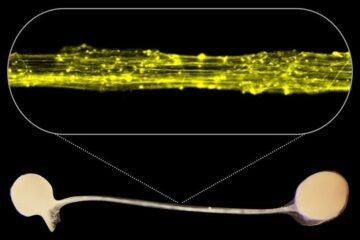New prion protein discovered by Canadian scientists may offer insight into mad cow disease

“For decades we believed PrP was a unique nerve protein that folded into an abnormal shape and caused prion disease: end of story. This view is no longer accurate,” Westaway adds.
The study was conducted jointly by the University of Toronto, University of Alberta, Case Western Reserve University (Ohio) and the McLaughlin Research Institute (Montana). The research is published today in the EMBO Journal and represents a culmination of work initiated at the University of Toronto in 1999, and then continued more recently at the University of Alberta.
This is the first discovery since 1985 of a new brain prion protein. “A second prion protein had been inferred by other research, based on indirect studies and the examination of DNA sequences,” said lead author Joel Watts, a graduate student at the University of Toronto’s Centre for Research in Neurodegenerative Diseases. “But we not only demonstrate that this theoretical protein really exists and shares several properties with healthy PrP; we have also defined an unexpected alteration in prion infections.
“As the PrP molecule alters shape and accumulates in a prion-affected brain, the Shadoo protein seems to disappear,” Watts added. Since proteins in a living cell are the molecules “that do the work, this is likely to be significant,” he said.
“Many facets of a prion disease like BSE are puzzling,” Westaway said. “The puzzles include the cause of death of brain cells, the function of normal prion proteins, and the rules governing emergence and spread of prions from animal to animal. We believe the Shadoo protein can give us a fresh purchase on these important questions.”
Media Contact
All latest news from the category: Life Sciences and Chemistry
Articles and reports from the Life Sciences and chemistry area deal with applied and basic research into modern biology, chemistry and human medicine.
Valuable information can be found on a range of life sciences fields including bacteriology, biochemistry, bionics, bioinformatics, biophysics, biotechnology, genetics, geobotany, human biology, marine biology, microbiology, molecular biology, cellular biology, zoology, bioinorganic chemistry, microchemistry and environmental chemistry.
Newest articles

First model of the brain’s information highways developed
Our human brain is not only bigger and contains more neurons than the brains of other species, but it is also connected in a special pattern: Thick bundles of neurons…

Why getting in touch with our ‘gerbil brain’ could help machines listen better
Macquarie University researchers have debunked a 75-year-old theory about how humans determine where sounds are coming from, and it could unlock the secret to creating a next generation of more…

Attosecond core-level spectroscopy reveals real-time molecular dynamics
Chemical reactions are complex mechanisms. Many different dynamical processes are involved, affecting both the electrons and the nucleus of the present atoms. Very often the strongly coupled electron and nuclear…





















